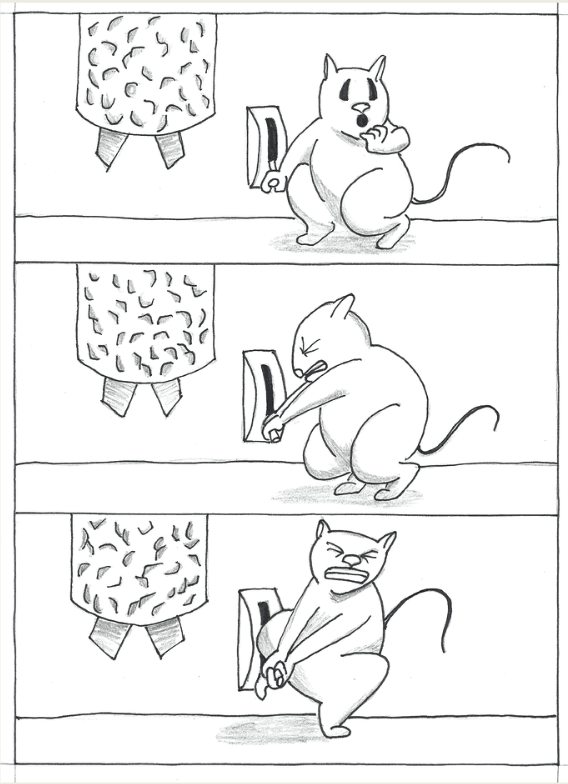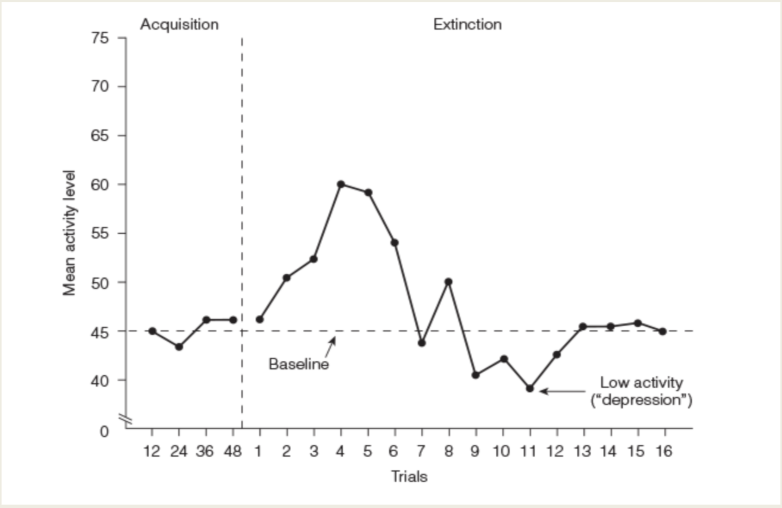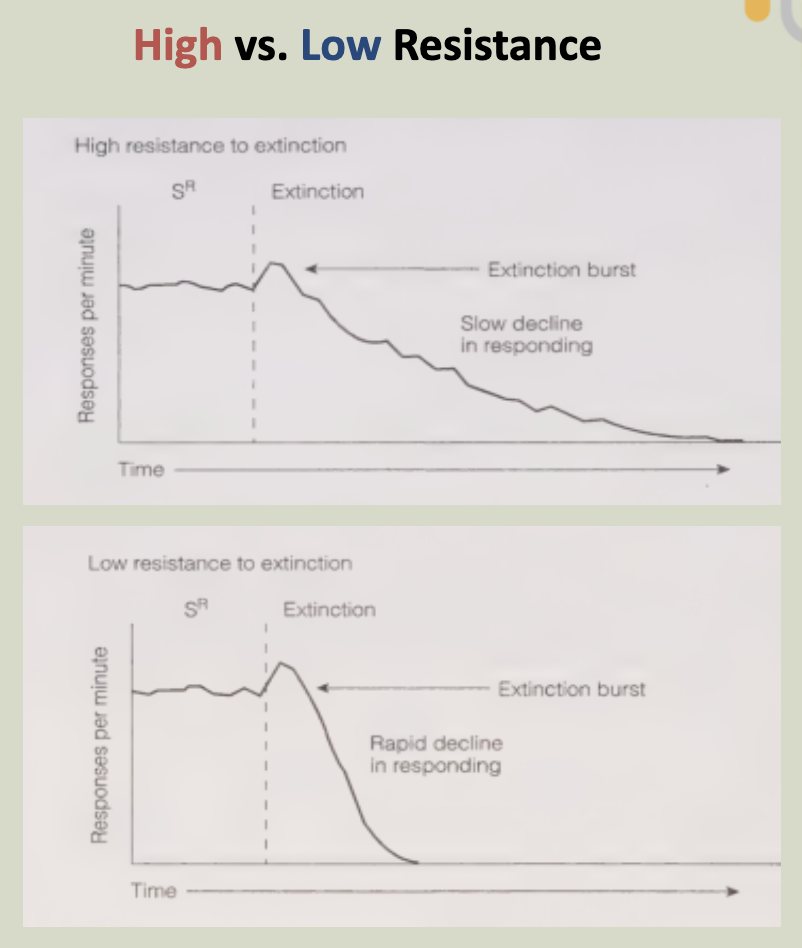Ch. 8: Extinction and Stimulus Control
1/18
There's no tags or description
Looks like no tags are added yet.
Name | Mastery | Learn | Test | Matching | Spaced |
|---|
No study sessions yet.
19 Terms
Side effects of extinction
Extinction burst
Increase in variability
Emotional behavior
Aggression
Resurgence
Depression
Extinction burst
Temporary increase in the frequency and intensity of responding when extinction is first implemented
Scientific example: a rat is reinforced every fourth lever press (FR 4 schedule) → when extinction is implemented, the rat will initially react by pressing the lever both more rapidly and more forcefully
Real world example: when the washing machines at my freshman year dorm would not start after I paid the fee on the machine, I kept pressing the button several times in a row, with increasing force each time I pressed it…

Increase in variability
If the rat typically pressed the lever with its right paw to get food, it might now try pressing it with its left paw
If the washing machine was not working again even after I paid, I would hold down the button to see if it would start
Emotional behavior
An emotional response to an extinction procedure – agitation, distress, anxiety, etc.
Scientific example: a rat pacing or squeaking when a lever stops dispensing food
Real world example: A child might receive attention whenever they throw a tantrum. A parent might implement extinction by no longer giving the child attention. The child may start feeling anxious and start hyperventilating.
Aggression
A type of emotional behavior that is common during an extinction procedure (Extinction-induced aggression or frustration-induced aggression)
Scientific example: a rat attacks another rat in the same cage, chew on the bars of the cage, or even aggressively scratch at the lever when the lever stops dispensing food
Real world example: if the child does not receive the attention they want, they may start hitting, kicking, or throwing objects
Resurgence
Reappearance of other behaviors during extinction that had previously been effective in obtaining reinforcement
Scientific example: Hull trained rats to run a 20ft pattern → 40ft pattern through a maze
Post extinction: rats persisted with the 40ft pattern → 20ft pattern → quitting
Real world example: A student used to pull all-nighters to cram study before an exam but shifts to consistent studying habits (reinforced by better grades and less stress)
Post extinction: reverts to pulling all-nighters and cramming
Depression
Extinction can lead to depressive-like symptoms
Depression → loss of reinforcement
Rats run down an alleyway for food → assessment of activity level in an open field test
With extinction implemented on the alleyway task:

Real world example: someone dies, family and friends essentially experience extinction and will become depressed
Resistance to extinction
The extent to which responding persists after an extinction procedure has been implemented
A response that is very persistent is said to have high resistance to extinction
A response that disappears quickly is said to have low resistance to extinction
Ex: a dog that continues to beg for food at the dinner table for 20 mins. after everyone has stopped feeding it has a much higher resistance to extinction than does a dog that stops begging after 5 mins.

Factors to resistance to extinction
Schedule of reinforcement
History of reinforcement
Magnitude of the reinforcer
Degree of deprivation
Previous experience with extinction
Distinctive signal for extinction
Spontaneous recovery
Schedule of reinforcement
Most important factor influencing resistance to extinction
Partial reinforcement effect
Resistance to extinction is particularly strong when behavior has been maintained on a variable interval or variable ratio schedule
Partial reinforcement effect
Behavior that has been maintained on an intermittent (partial) schedule of reinforcement will extinguish more slowly than behavior that has been maintained on a continuous schedule
Ex: lever pressing that has been reinforced on an FR 10 schedule will take longer to extinguish than lever pressing that has been reinforced on a CRF (FR 1) schedule
The less frequent + less predictable the reinforcer, the longer it takes the person or animal to “discover” that reinforcement is no longer available
Helps account for certain types of annoying or maladaptive behaviors
History of reinforcement
The more reinforcers that an individual has received for a behavior, the greater the resistance to extinction
Ex: lever pressing will extinguish more rapidly if a rat has previously earned only 10 reinforcers for lever pressing than if it has earned 100 reinforcers
Much easier to extinguish an unwanted behavior (i.e. whining for candy) when it first becomes evident
Magnitude of the reinforcer
Large-magnitude reinforcers sometimes result in greater resistance to extinction than small-magnitude reinforcers
Ex: lever pressing might take longer to extinguish following a training period in which each reinforcer consisted of a large pellet of food than if the reinforcer were a small pellet of food
Could also take longer to extinguish if the reinforcer was a highly preferred food item than if it were a less preferred food item
Effect of reinforcer magnitude on resistance to extinction is not entirely consistent → smaller reinforcers can sometimes result in greater resistance to extinction
Ex: a dog’s behavior of begging at the dinner table might extinguish more easily if you first spend several days feeding it small bites of less preferred morsels
Degree of deprivation
The greater the level of deprivation, the greater the resistance to extinction
Ex: a rat that is only slightly hungry will cease lever pressing more quickly than a rat that is very hungry
Previous experience with extinction
When sessions of extinction are alternated w/ sessions of reinforcement, the greater the # of exposures to extinction, the greater the behavior will extinguish during subsequent exposures
Ex: if a rat experiences several sessions of extinction randomly interspersed w/ several sessions of reinforcement, it will eventually learn to stop lever pressing soon after the start of an extinction session
Distinctive signal for extinction
Extinction occurs more quickly when there is a distinctive stimulus that signals the onset of extinction
Such stimulus = distinctive stimulus for extinction
If a parent consistently ignores a child’s tantrums when they sit down w/ a book in hand, the child learns that tantrums will not be reinforced when the parent is reading
Spontaneous recovery
The reappearance of an extinguished response, despite the continued absence of reinforcement, following a rest period after extinction
Ex: we extinguish a rat’s behavior of lever pressing → the next day, when we place the rat back in the experimental chamber, it will probably commence lever pressing again
Forgot that lever pressing no longer produces food
Behavior will likely be weaker than it was at the start of the extinction phase the day before and will extinguish more quickly → we continue to withhold reinforcement
Process might repeat itself several times → each recovery gets weaker and weaker (eventually spontaneous recovery won’t occur)
May be a function of discriminative stimuli
Ex: the rat’s experience of being taken from the home cage, weighed, and placed in an operant chamber is a signal for the availability of food
Will stop pressing lever when it realizes that it won’t receive food when it repeatedly is exposed to these events
Differential reinforcement of other behavior (DRO)
Extinguishing the target behavior and reinforcing the occurrence of a replacement behavior
Reinforcement of any behavior other than the target behavior that is being extinguished
Ex: you extinguish a child’s habit of whining for candy but also explicitly reinforce alternative behaviors, especially the behavior of being well-mannered
They can still obtain candy, but only if they exhibit an appropriate pattern of behavior
The candy can be gradually phased out or replaced by a healthier treat (as the appropriate behavior becomes firmly established)
More effective than simple extinction procedures → weakened both by:
The lack of reinforcement for that behavior
The reinforcement of alternative behaviors that come to replace it
Functional communication training (differential reinforcement of functional communication)
Many unwanted behaviors occur because the child is attempting to attain an important reinforcer (i.e. attention) but is doing so inappropriately
The behavior is clearly and appropriately communicating one’s desired is differentially reinforced